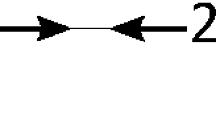Abstract
In this paper, we modify the Langevin dynamics associated to the generalized Curie–Weiss model by introducing noisy and dissipative evolution in the interaction potential. We show that, when a zero-mean Gaussian is taken as single-site distribution, the dynamics in the thermodynamic limit can be described by a finite set of ODEs. Depending on the form of the interaction function, the system can have several phase transitions at different critical temperatures. Because of the dissipation effect, not only the magnetization of the systems displays a self-sustained periodic behavior at sufficiently low temperature, but, in certain regimes, any (finite) number of stable limit cycles can exist. We explore some of these peculiarities with explicit examples.



Similar content being viewed by others
References
Acebrón, J.A., Bonilla, L.L., Vicente, C.J.P., Ritort, F., Spigler, R.: The Kuramoto model: a simple paradigm for synchronization phenomena. Rev. Mod. Phys. 77(1), 137 (2005)
Bertini, L., Giacomin, G., Pakdaman, K.: Dynamical aspects of mean field plane rotators and the Kuramoto model. J. Stat. Phys. 138(1–3), 270–290 (2010)
Carletti, T., Villari, G.: A note on existence and uniqueness of limit cycles for Liénard systems. J. Math. Anal. Appl. 307(2), 763–773 (2005)
Chen, W.-C.: Nonlinear dynamics and chaos in a fractional-order financial system. Chaos Solitons Fractals 36(5), 1305–1314 (2008)
Chen, X., Llibre, J., Zhang, Z.: Sufficient conditions for the existence of at least \(n\) or exactly \(n\) limit cycles for the Liénard differential systems. J. Differ. Equ. 242, 11–23 (2007)
Collet, F., Dai Pra, P.: The role of disorder in the dynamics of critical fluctuations of mean field models. Electron. J. Probab 17(26), 1–40 (2012)
Collet, F., Dai Pra, P., Formentin, M.: Collective periodicity in mean-field models of cooperative behavior. Nonlinear Differ. Equ. Appl. NoDEA 22(5), 1461–1482 (2015)
Collet, F., Formentin, M., Tovazzi, D.: Rhythmic behavior in a two-population mean-field Ising model. Phys. Rev. E 94(4), 042139 (2016)
Dai Pra, P., Fischer, M., Regoli, D., Regoli, D.: A Curie-Weiss model with dissipation. J. Stat. Phys. 152(1), 37–53 (2013)
Dai Pra, P., Giacomin, G., Regoli, D.: Noise-induced periodicity: some stochastic models for complex biological systems. In: Mathematical Models and Methods for Planet Earth, pp. 25–35. Springer, Berlin (2014)
Dawson, D.A.: Critical dynamics and fluctuations for a mean-field model of cooperative behavior. J. Stat. Phys. 31(1), 29–85 (1983)
Ditlevsen, S., Löcherbach, E.: Multi-class oscillating systems of interacting neurons. Stoch. Process. Appl. 127, 1840–1869 (2016)
Eisele, T., Ellis, R.S.: Multiple phase transitions in the generalized Curie-Weiss model. J. Stat. Phys. 52(1–2), 161–202 (1988)
Ellis, R.S., Newman, C.M.: Limit theorems for sums of dependent random variables occurring in statistical mechanics. Zeitschrift für Wahrscheinlichkeitstheorie und verwandte Gebiete 44(2), 117–139 (1978)
Ermentrout, G.B., Terman, D.H.: Mathematical Foundations of Neuroscience, vol. 35. Springer, Berlin (2010)
Giacomin, G., Poquet, C.: Noise, interaction, nonlinear dynamics and the origin of rhythmic behaviors. Braz. J. Probab. Stat. 29(2), 460–493 (2015)
Ikeda, N., Watanabe, S.: Stochastic Differential Equations and Diffusion Processes. Elsevier, New York (2014)
Lindner, B., Garcıa-Ojalvo, J., Neiman, A., Schimansky-Geier, L.: Effects of noise in excitable systems. Phys. Rep. 392(6), 321–424 (2004)
Odani, K.: Existence of exactly \(N\) periodic solutions for Liénard systems. Funkcialaj Ekvacioj 39, 217–234 (1996)
Scheutzow, M.: Noise can create periodic behavior and stabilize nonlinear diffusions. Stoch. Process. Appl. 20(2), 323–331 (1985)
Sznitman, A.-S.: Topics in propagation of chaos. In: Ecole d’Eté de Probabilités de Saint-Flour XIX—1989, pp. 165–251. Springer, Berlin (1991)
Touboul, J.: The hipster effect: when anticonformists all look the same. arXiv preprint arXiv:1410.8001 (2014)
Touboul, J., Hermann, G., Faugeras, O.: Noise-induced behaviors in neural mean field dynamics. SIAM J. Appl. Dyn. Syst. 11(1), 49–81 (2012)
Turchin, P., Taylor, A.D.: Complex dynamics in ecological time series. Ecology 73(1), 289–305 (1992)
Weidlich, W., Haag, G.: Concepts and Models of a Quantitative Sociology: The Dynamics of Interacting Populations, vol. 14. Springer, Berlin (2012)
Acknowledgements
The authors wish to thank Paolo Dai Pra for having suggested the idea of this work and for all the useful discussions on it and Marco Formentin for the suggestions and comments. This work was partially supported by the INdAM-GNAMPA Project 2017 “Collective periodic behavior in interacting particle systems”. L. A. acknowledges the partial support by Centro Studi Levi Cases (Università di Padova).
Funding
Funding were provided by Università degli Studi di Padova and Weierstrass Institute.
Author information
Authors and Affiliations
Corresponding author
Rights and permissions
About this article
Cite this article
Andreis, L., Tovazzi, D. Coexistence of Stable Limit Cycles in a Generalized Curie–Weiss Model with Dissipation. J Stat Phys 173, 163–181 (2018). https://doi.org/10.1007/s10955-018-2127-5
Received:
Accepted:
Published:
Issue Date:
DOI: https://doi.org/10.1007/s10955-018-2127-5




